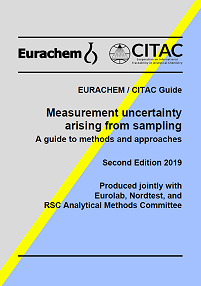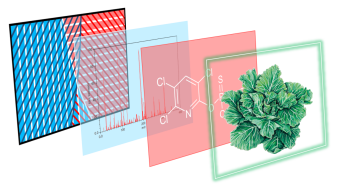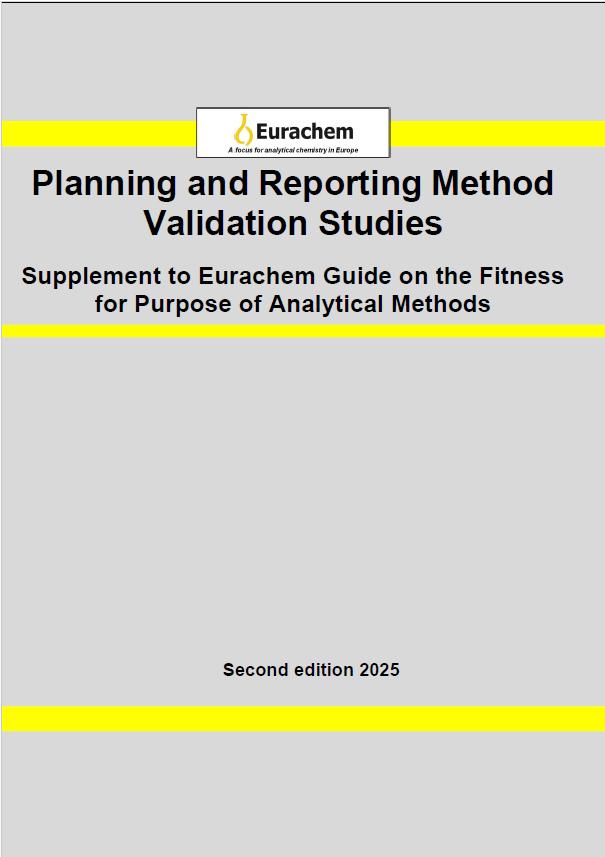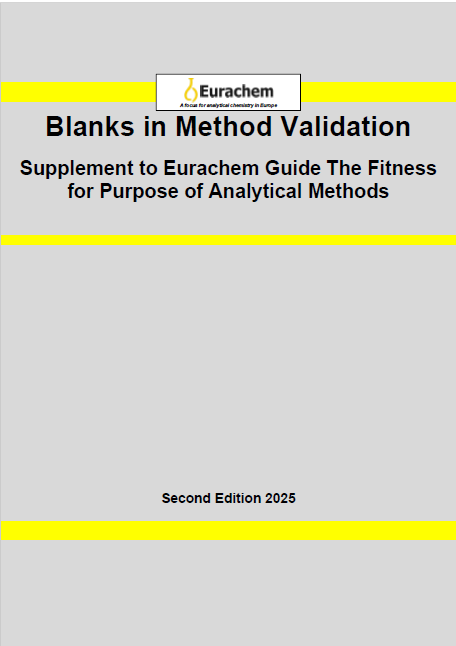Measurement uncertainty arising from sampling (2nd edition, 2019)
- Details
-
Last Updated: Thursday, 30 October 2025 14:49
Full title
 Measurement uncertainty arising from sampling: A guide to methods and approaches
Measurement uncertainty arising from sampling: A guide to methods and approaches
Second edition (2019)
Contents
This Guide aims to describe various methods that can be used to estimate the uncertainties arising from the processes of sampling and the physical preparation of samples. It is intended primarily for specialists such as sampling planners and for analytical chemists who need to estimate the uncertainty associated with their measurement results.
The Guide deals with the case where the measurand is defined in term of the value of the analyte concentration in a sampling target, rather than in just the sample delivered to the laboratory. In this case, the sampling process affects the result and its uncertainty, and sampling is necessarily considered as part of the measurement process. This Guide takes a holistic view of the measurement process to include sampling and sample preparation as well as the analytical process.
The Guide begins by explaining the importance of the total uncertainty in a measurement for making reliable interpretation of measurements, and judging their fitness for purpose. It covers the whole measurement process, defining each of the component steps, and describing the effects and errors that cause uncertainty in the final result, with particular attention to sampling issues.
Two main approaches to the estimation of uncertainty from sampling are described. The empirical approach uses repeated sampling and analysis, under various conditions, to quantify the effects caused by factors such as the heterogeneity of the analyte in the sampling target and variations in the application of one or more sampling protocols, to quantify uncertainty (and usually some of its component parts). The modelling approach uses a predefined model that identifies each of the component parts of the uncertainty, making estimates of each component, and sums them in order to make an overall estimate.
For either approach, the Guide follows the principles of the ISO Guide to the Expression of Uncertainty in Measurement, interpreted for analytical measurement in the Eurachem guide "Quantifying Uncertainty in Analytical Measurement" which is available here.
This Second Edition includes a number of additions and changes. These include
- the expression of uncertainty of measurement as an 'uncertainty factor' (FU) when the frequency distribution describing the sampling uncertainty is log-normal rather than normal, and guidance on the use of an uncertainty factor in an uncertainty budget.
- the use of an unbalanced design to estimate uncertainty more cost-effectively than can be achieved using the balanced ‘duplicate method’ design;
- updates to definitions and references to reflect current international documents and literature, including applications of these methods to on-site and in situ measurements, made at both the macro and the micro scale.
Availability
From this website:
* Also available from the ISS website.
Additional translations:
Note: In parallel with this Eurachem Guide on sampling uncertainty, Nordtest developed a shorter handbook on sampling, which is available from the Nordtest website.
Editorial corrections
A small number of editorial corrections have been identified since the edition above was approved. These are listed in the sheet of Errata below.
Note: The Spanish edition (UfS:2019.P2-ES) published 2021-05-25 includes the corrections listed in the above correction list, up to errata version 1.2.
Citation
This Guide should be cited* as:
M H Ramsey, S L R Ellison and P Rostron (eds.) Eurachem/EUROLAB/ CITAC/Nordtest/AMC Guide: Measurement uncertainty arising from sampling: a guide to methods and approaches. Second Edition, Eurachem (2019). ISBN (978-0-948926-35-8). Available from http://www.eurachem.org
*Subject to journal requirements.
Translations
Translation into other languages is permitted for members of Eurachem. Other offers of translation should be directed to the Eurachem Secretariat for permission. The Eurachem policy on maintenance and development of Eurachem guidance, available on the Policies page, gives further information on translation.
Translations of the First edition can be found in the publication archive, here.
Assessment of performance and uncertainty in qualitative chemical analysis
- Details
-
Last Updated: Wednesday, 18 December 2024 01:59
Introduction
 Many decisions with socio-economic or individual impact depend on qualitative analysis, including decisions related to food safety, clinical diagnosis, and forensic evidence, are based primarily on qualitative, rather than quantitative, chemical analysis. Qualitative analysis is analysis that returns a classification rather than a numerical value, such as the identity of a chemical substance, the type of plastic of a microparticle, the potential source of an oil spill, the presence of a banned sports doping substance, or the presence of accelerant in fire debris. Sometimes, such classifications rely solely on qualitative tests; others may use measurement results (such as line frequencies in a spectrum) to reach a conclusion.
Many decisions with socio-economic or individual impact depend on qualitative analysis, including decisions related to food safety, clinical diagnosis, and forensic evidence, are based primarily on qualitative, rather than quantitative, chemical analysis. Qualitative analysis is analysis that returns a classification rather than a numerical value, such as the identity of a chemical substance, the type of plastic of a microparticle, the potential source of an oil spill, the presence of a banned sports doping substance, or the presence of accelerant in fire debris. Sometimes, such classifications rely solely on qualitative tests; others may use measurement results (such as line frequencies in a spectrum) to reach a conclusion.
Qualitative analysis, like quantitative analysis, needs to be demonstrably reliable. Part of the purpose of the guide is accordingly to show how the performance of a qualitative analysis procedure can be quantified to ensure its fitness for purpose. Practical difficulties and limitations in reliable quantification of low false result rates are discussed, and recommendations are made for checking the validity of these analyses. Brief recommendations are also made for ensuring that any measurements undertaken in the course of a qualitative analysis are reliable.
Although laboratories accredited following the ISO/IEC 17025 standard are not currently required to express qualitative analysis results with uncertainty, the guide provides some metrics that can be used to convey the level of confidence in conclusions from qualitative analysis. In addition, the guide provides suggestions for reporting results with an indication of confidence if desired.
This guide does not make recommendations on whether or not laboratories should routinely report information on the confidence, or uncertainty, associated with qualitative analysis results. Nevertheless, an understanding of performance, or of the uncertainty associated with a qualitative analysis result, can help laboratories to better advise customers; it can also help to identify quality improvements or determine (for example) whether additional confirmatory tests might be needed.
This Eurachem/CITAC guide accordingly aims to provide some tools to help improve the quality of qualitative analysis and of their interpretation, to make sure that interests dependent on these analyses are well protected.
Content of the guide
This guide includes information on
- The nature and relevance of qualitative analysis.
- Different types of qualitative analysis - for example, those that depend on qualitative tests alone, and others that use quantitative information to come to a conclusion.
- Experimental and other strategies for estimating false response rates, which are fundamental to establishing reliability.
- Expressions of confidence in qualitative analysis.
- Reporting qualitative analysis results.
- Examples showing how false response rates and other metrics can be determined.
- The statistical basis for some important measures of confidence in a qualitative result.
Availability
The guide may be downloaded from this website at no cost.
* First published 2021-11-11. Publication dates above are dates of file publication on this website.
Translation
Translation into other languages is permitted for members of Eurachem. Other offers of translation should be directed to the Eurachem Secretariat for permission. The Eurachem policy on maintenance and development of Eurachem guidance, available on the Policies page, gives further information on translation.
Citation
This guidance should be cited* as
"R Bettencourt da Silva and S L R Ellison (eds.) Eurachem/CITAC Guide: Assessment of performance and uncertainty in qualitative chemical analysis. First Edition, Eurachem (2021). ISBN 978-0-948926-39-6.
Available from www.eurachem.org."
*Subject to journal requirements.
Previous editions
There are no earlier editions of this Guide.
 Planning is an essential stage in the validation process. Before starting any experimental work, the aim should be to have a clear plan for the entire validation study. This should cover the performance characteristics that will be studied, the target value for each performance characteristic, the materials that will be analysed, the level of replication and order of the experiments, any statistical analysis that will be used, and how the method will be judged as being fit for purpose.
Planning is an essential stage in the validation process. Before starting any experimental work, the aim should be to have a clear plan for the entire validation study. This should cover the performance characteristics that will be studied, the target value for each performance characteristic, the materials that will be analysed, the level of replication and order of the experiments, any statistical analysis that will be used, and how the method will be judged as being fit for purpose.



 Blanks are an important tool and are used in the determination of most performance characteristics during a validation process. They are also often included in each analytical run during routine use of the measurement procedure. There are many different types of blanks and the analyst must consider which blanks to include during preparation of the validation plan.
Blanks are an important tool and are used in the determination of most performance characteristics during a validation process. They are also often included in each analytical run during routine use of the measurement procedure. There are many different types of blanks and the analyst must consider which blanks to include during preparation of the validation plan. Guidance is given on how to validate a measuring procedure that includes the primary sampling (VaMPIS). It is a supplement to existing Eurachem guidance on “The Fitness for Purpose of Analytical Methods” and “Measurement Uncertainty arising from Sampling”. The overall aim is to extend the concept of ‘validation of a measurement procedure’ beyond the validation of the analytical method (or procedure) alone, in order to include the primary sampling (and physical sample preparation) within the validation process.
Guidance is given on how to validate a measuring procedure that includes the primary sampling (VaMPIS). It is a supplement to existing Eurachem guidance on “The Fitness for Purpose of Analytical Methods” and “Measurement Uncertainty arising from Sampling”. The overall aim is to extend the concept of ‘validation of a measurement procedure’ beyond the validation of the analytical method (or procedure) alone, in order to include the primary sampling (and physical sample preparation) within the validation process. Measurement uncertainty arising from sampling: A guide to methods and approaches
Measurement uncertainty arising from sampling: A guide to methods and approaches Many decisions with socio-economic or individual impact depend on qualitative analysis, including decisions related to food safety, clinical diagnosis, and forensic evidence, are based primarily on qualitative, rather than quantitative, chemical analysis. Qualitative analysis is analysis that returns a classification rather than a numerical value, such as the identity of a chemical substance, the type of plastic of a microparticle, the potential source of an oil spill, the presence of a banned sports doping substance, or the presence of accelerant in fire debris. Sometimes, such classifications rely solely on qualitative tests; others may use measurement results (such as line frequencies in a spectrum) to reach a conclusion.
Many decisions with socio-economic or individual impact depend on qualitative analysis, including decisions related to food safety, clinical diagnosis, and forensic evidence, are based primarily on qualitative, rather than quantitative, chemical analysis. Qualitative analysis is analysis that returns a classification rather than a numerical value, such as the identity of a chemical substance, the type of plastic of a microparticle, the potential source of an oil spill, the presence of a banned sports doping substance, or the presence of accelerant in fire debris. Sometimes, such classifications rely solely on qualitative tests; others may use measurement results (such as line frequencies in a spectrum) to reach a conclusion.